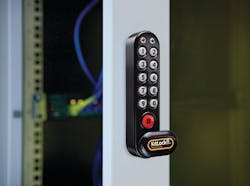Over the years, technology has significantly improved the performance of the battery-operated digital lock making it increasingly more sophisticated. One innovation improving the way in which digital cabinet and locker lock access permissions are managed is the ability to issue codes remotely. Codelocks has launched a new secure web-based application called NetCode that allows time-sensitive access codes to be generated for an individual or group of KitLock electronic locks, all from a remote location.
The application is particularly useful if you are a field service manager (FSM) granting temporary access to machinery or equipment locked inside cabinets, so that authorized personnel can gain access unaccompanied. For example, access may be required for routine or one-off maintenance purposes to servers secured in racks or enclosures in data centers or plant and machinery within utility cabinets.
NetCode-enabled digital locks are also ideal for use with courier drop boxes or short- to medium-term locker rentals, where the access code is only needed for a specific order or length of time. Time-sensitive access codes are a more secure way to grant access, as the code will not work outside a designated timeslot.
Using the NetCode portal, lock owners can generate a code and send it directly to the person needing access via an SMS text message or email. The application works by configuring the locks prior to dispatch with a unique matching algorithm to the web-based software, which allows the software to predict the access code on the installed lock at any given time. The locks are activated on the NetCode portal before they are installed at a remote site. The NetCode portal then enables lock owners to create time-sensitive access codes from any browser-capable, Internet-enabled device, removing the need for them to be physically present at the time access is required.
NetCode also allows lock owners to set up and manage a “whitelist” of authorized cell phones, allowing any phone on the list to request a short-term access code via an inbound SMS message. For example, if you are a service engineer making several site visits in one day, all you need to do is arrive onsite and request a NetCode using the authorized cell phone. The access code is generated automatically and will only work for up to one hour.
Registration of up to ten locks on the NetCode portal is free of charge. To register more than ten locks, a small annual service fee applies. SMS credit packs are also available, allowing up to 100 NetCodes to be sent via text message.
To help lock owners set up and manage their NetCode-enabled locks, Codelocks has created a series of tutorial videos. The videos show how to create an account on the NetCode portal and start generating codes, how to set up and manage a ‘whitelist’ of authorized cell phones, and how to customize a NetCode account. To see the videos, visit www.codelocks.us/news/videos. For more detailed product information visit www.codelocks.us/kitlock/kl1000-netcode-locker-lock.html.
Grant Macdonald is president of Codelocks Inc.
KitLock 1000 NetCode Features
• 10-button keypad
• 8 digit Master Code
• 12 digit NetCode
• 4 digit User NetCode option
• 15,000 openings from 2 x AAA cells
• Battery override
• IP55 rated – when fitted with gasket
• All parts/fixings/templates included
• Easy installation
The NetCode Process
Here is how you can create a NetCode that will work between a start and end date, ideal for long durations, or create a NetCode that will work at a particular date and time, ideal for short durations of up to one day.
Create an online account and register your lock on the NetCode portal at www.kitlock.net
Activate your lock and install before shipping the locks to remote locations for installation
When requested, create individual NetCodes from any browser capable, Internet-enabled device
Send codes via SMS or email to personnel in the field who have requested access
View history of each lock – displays all codes created for a lock including start date, duration, who received the code and any additional notes
Customize your portal and notifications





